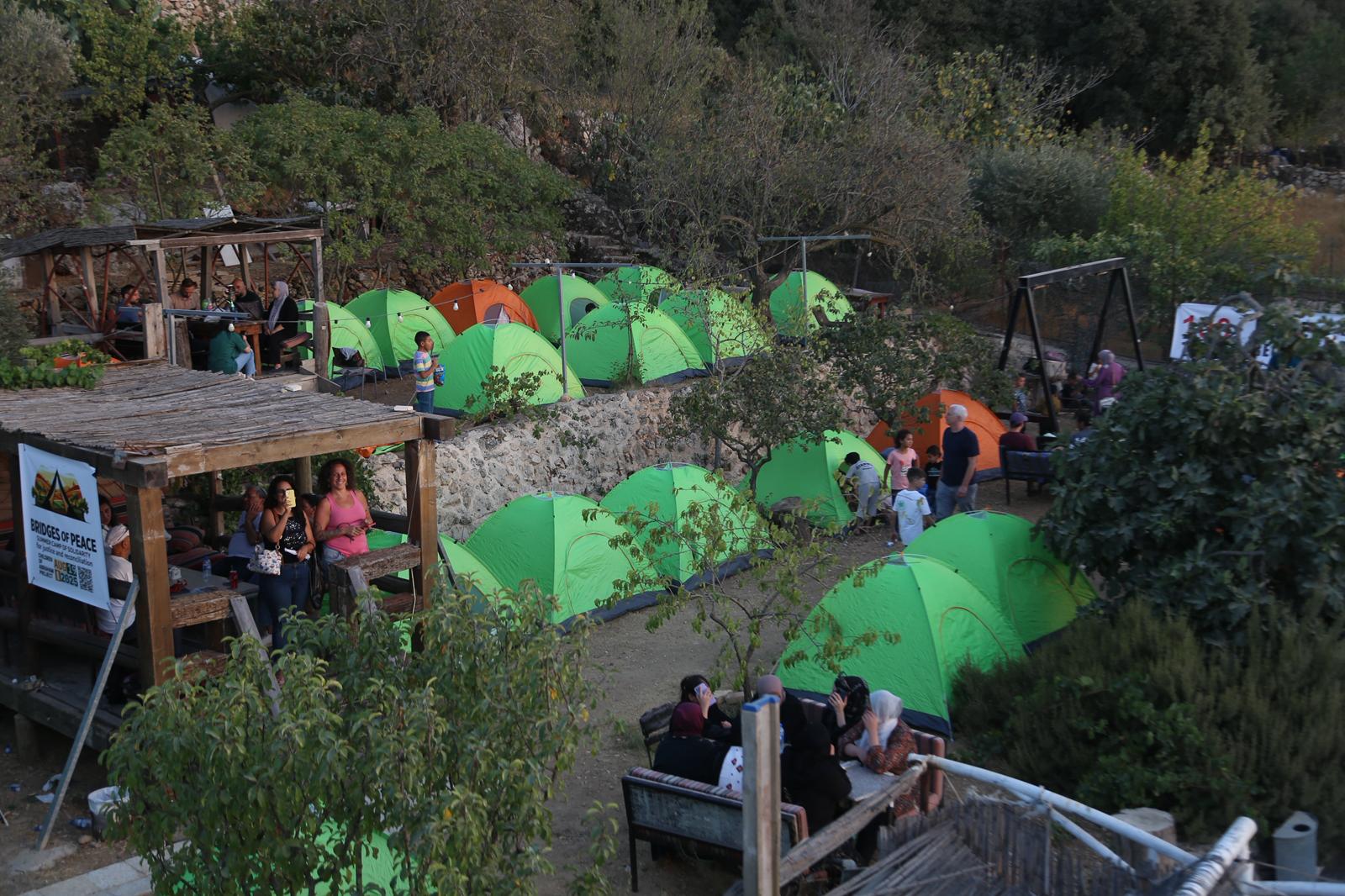Written by Mohamed Jamous
In the heart of Beit Jala, where landscapes intertwine with history, and pain overlaps with dreams, 100 tents were raised as part of the “100 Tents for Justice and Reconciliation” initiative. It was not a protest nor a political rally but a heartfelt cry: “We want to hear each other. We want to heal.
Over the course of two days, Tuesday and Wednesday, August 2025, around 200 Palestinian and Israeli participants gathered to camp together in Area C, a location that itself reflects the complexities of identity, belonging, and the ongoing conflict. The event was organized by the Children of Abraham Project, a US-registered nonprofit committed to fostering interfaith and intercultural understanding.

From every corner of this wounded land, they came…
Two hundred people from across the West Bank and from towns within Israel defied checkpoints, violence, and deep-rooted fears and walked toward Beit Jala carrying one shared desire: to meet, to love, not to divide. They came armed with hope, overcoming anxiety, tension, and threats, raising their voices against the heavy darkness overshadowing the Holy Land. They did not come to argue but to love. They did not raise slogans but opened their hearts.
Children with eyes wide open to life, wise women, elders bearing the memory of the land, and youth dreaming of a different reality—from many ages, religions, and nationalities—gathered in the heart of Beit Jala, not to erase their differences but to unite them in a single love… sincere, human, and rare.

Leading the local efforts was Mohamed Jamous, a Palestinian peace activist, humanitarian, and community leader from Ramallah, with more than 15 years of experience working in the field of peacebuilding and conflict transformation.
Mohamed Jamous: A Voice for Humanity and Coexistence
Mohamed is known for his work promoting unity between cultures, religions, and nationalities. His leadership goes far beyond grassroots activism—he has spearheaded humanitarian campaigns, supported vulnerable communities, and participated in international forums to bring global attention to the lived realities in Palestine.
“My work isn’t easy,” he often says, “but it’s necessary. Because people here despite everything—still believe that peace is possible.

Courage in the Face of Fear
What made this event truly exceptional was not the tents, or the music, or even the carefully organized schedule. It was the courage of the people who came—especially the Palestinians who, despite trauma, fear, and political pressure, chose to be there.
For many, attending such a gathering was not an easy decision. Sitting side by side with Israeli participants, sharing personal narratives, and reliving painful memories it came with emotional weight, social risk, and political complications. Some came quietly. Some hesitated. But still, they came.
They came, carrying their pain and their hope on their shoulders, because they know that healing begins when we choose to see each other as human.

As Mohamed shared during the opening circle:
Peace work is not easy. It’s incredibly difficult, frightening, and filled with risk. But people keep showing up. Not because it’s safe but because it matters. Because deep down, they know that peace is worth the cost.”
Stories That Heal, Not Divide
Throughout the two-day gathering, participants sat in small dialogue circles where they shared their lived experiences and stories of loss, resistance, fear, and faith. Some had lost loved ones. Others had grown up surrounded by walls, checkpoints, and narratives that paint the “other side” as a threat.
Yet, inside those tents, something shifted. Listening became a form of solidarity. Speaking became a way of reclaiming dignity. And pain, shared honestly, became the unlikely bridge between enemies.
The event also featured children’s activities like face painting, live music, and moments of laughter that reminded everyone that joy, too, is a form of resistance.
Opening Remarks and Shared Leadership
The gathering opened with warm words from Jerry Katz, president of The Children of Abraham, followed by Mohamed Jamous and key facilitators and organizers, including Stephen Aiello, David Wallz, and Yoel Oz, who played instrumental roles in guiding the circles and providing a safe, inclusive atmosphere.

A History of Bold, Human-Centered Peace Initiatives
This event is not an isolated act. It follows a legacy of brave and meaningful peace efforts led by Jamous and his team. One of the most widely celebrated was the largest interfaith Ramadan Iftar of 2025, which brought together over 1,000 Palestinians from the West Bank and Jerusalem with Jewish Israelis, a moment broadcast internationally as a symbol of unity in the face of division.
The Core Message: Peace Is Still Possible
Though humble in format, the “100 Tents for Justice and Reconciliation” gathering carried a powerful message to the region and to the world: True peace begins when we dare to listen not with the intent to respond, but with the courage to understand.
Despite walls, fears, and generations of mistrust, people still come together.
Despite trauma and loss, people still believe.
And despite all odds, peace is still possible.

Leave a Reply